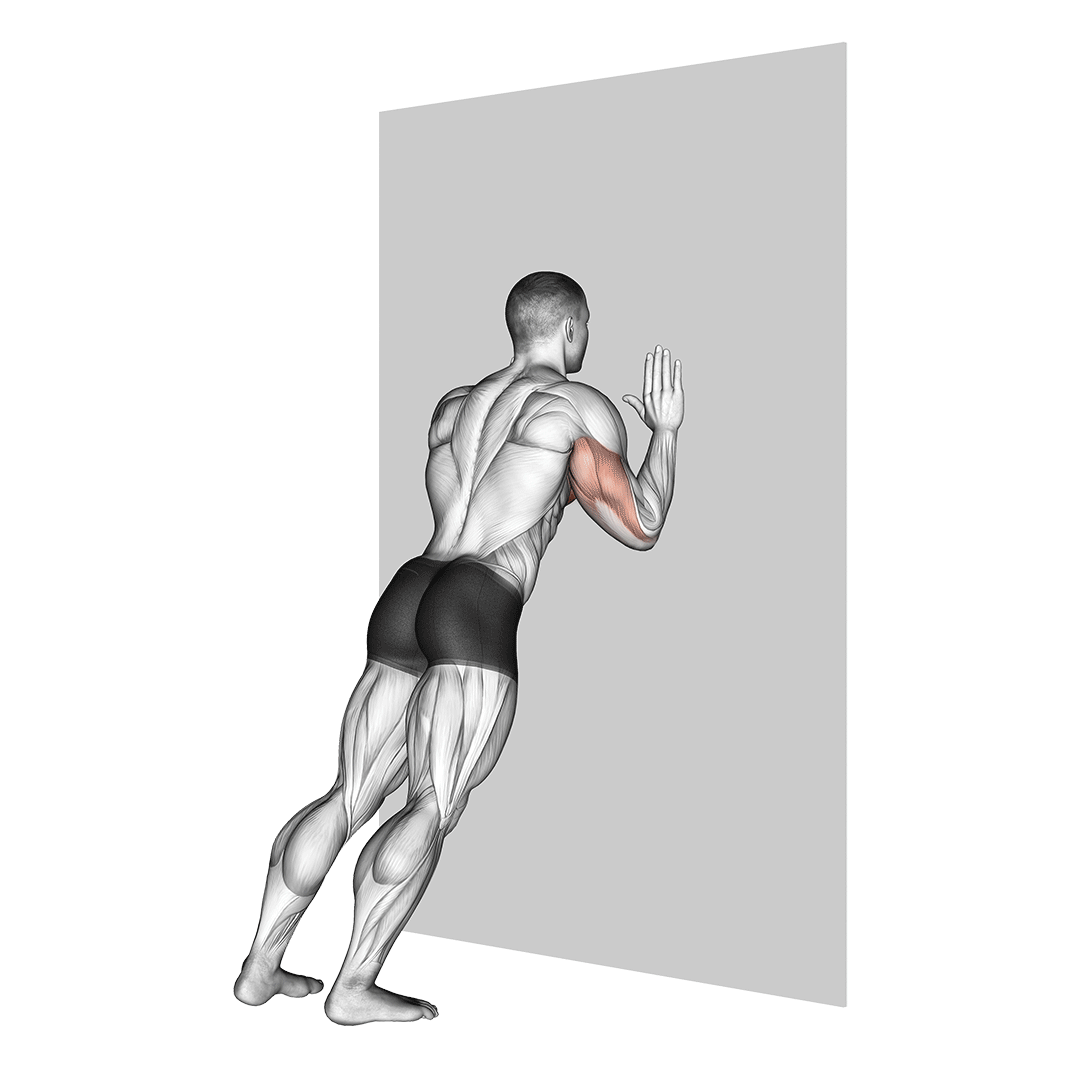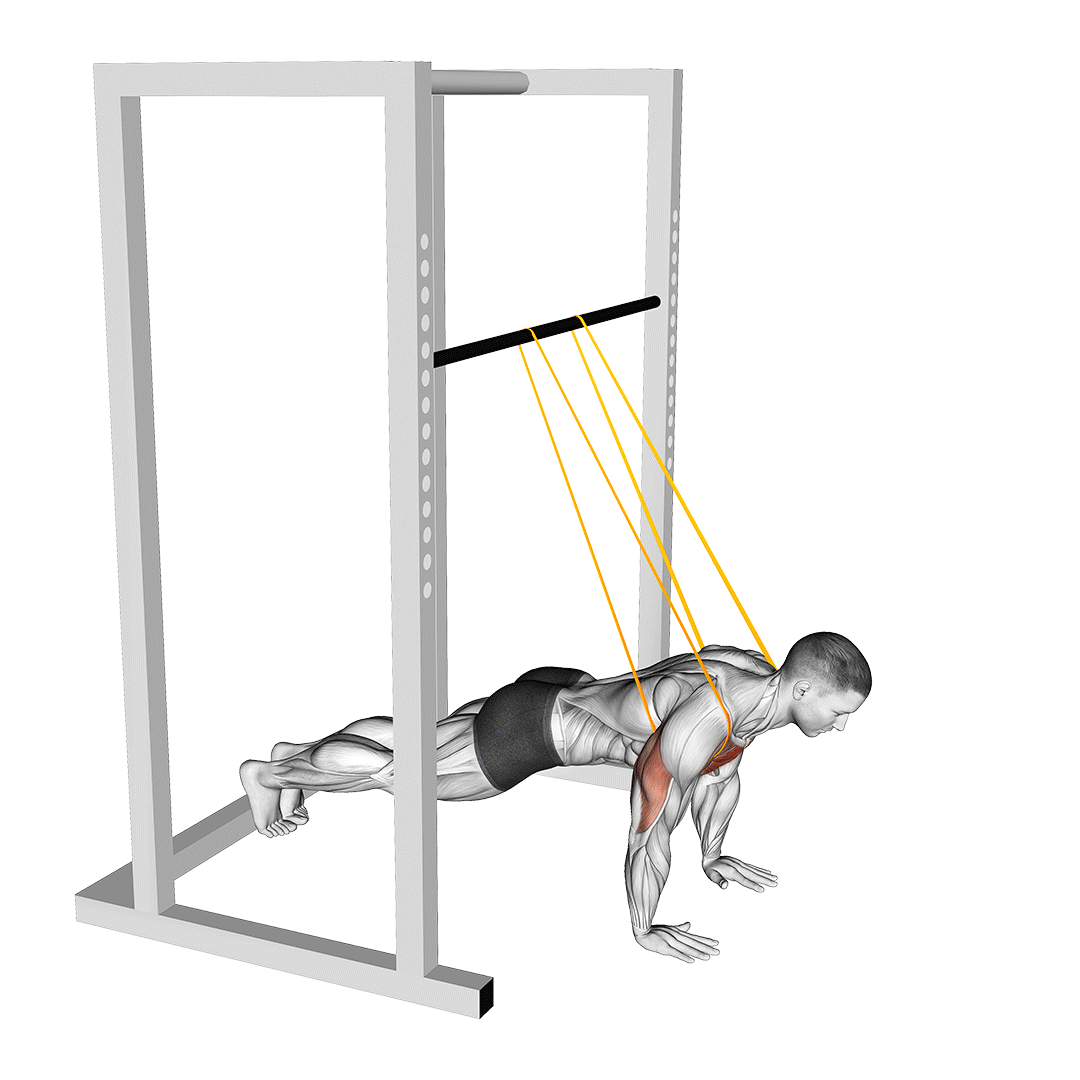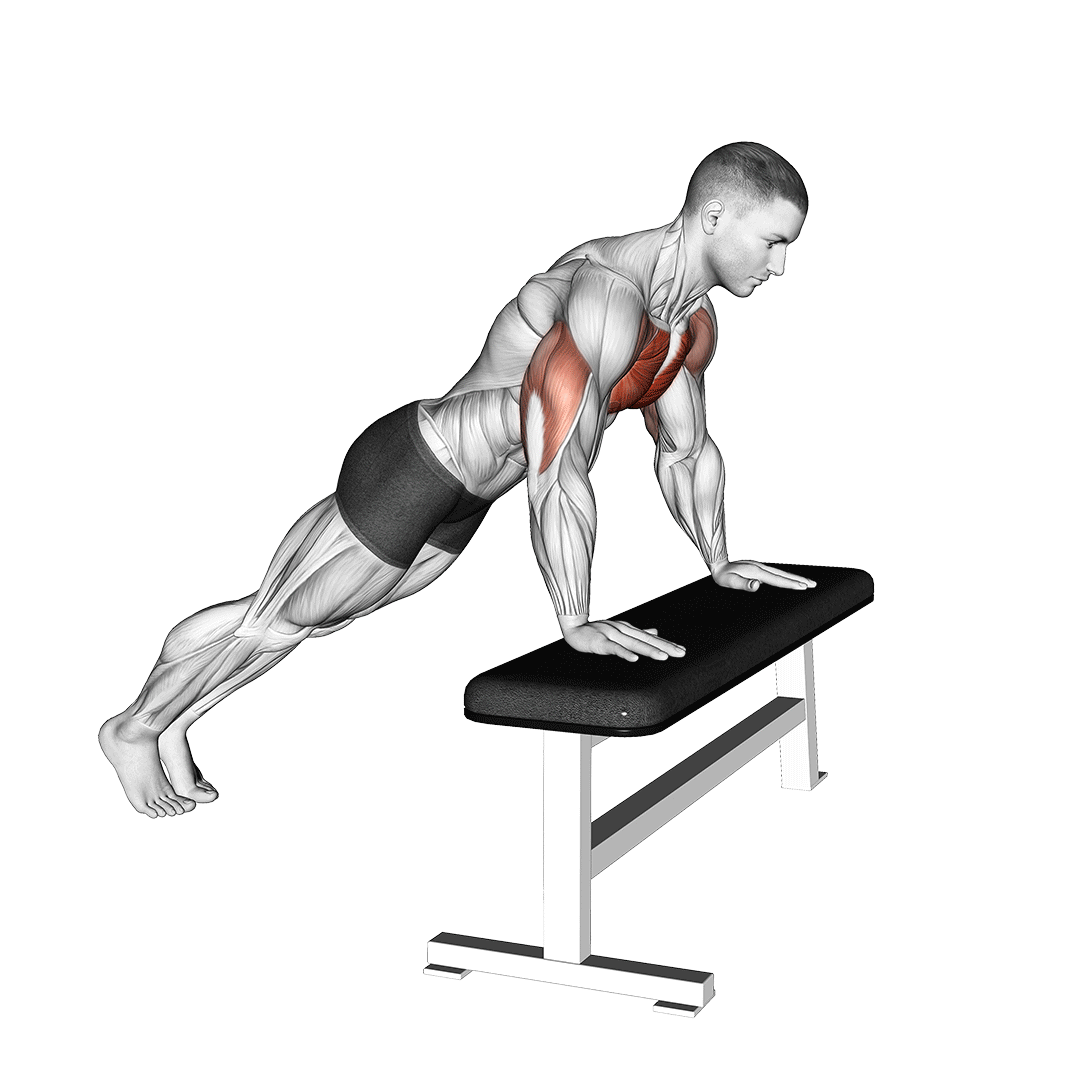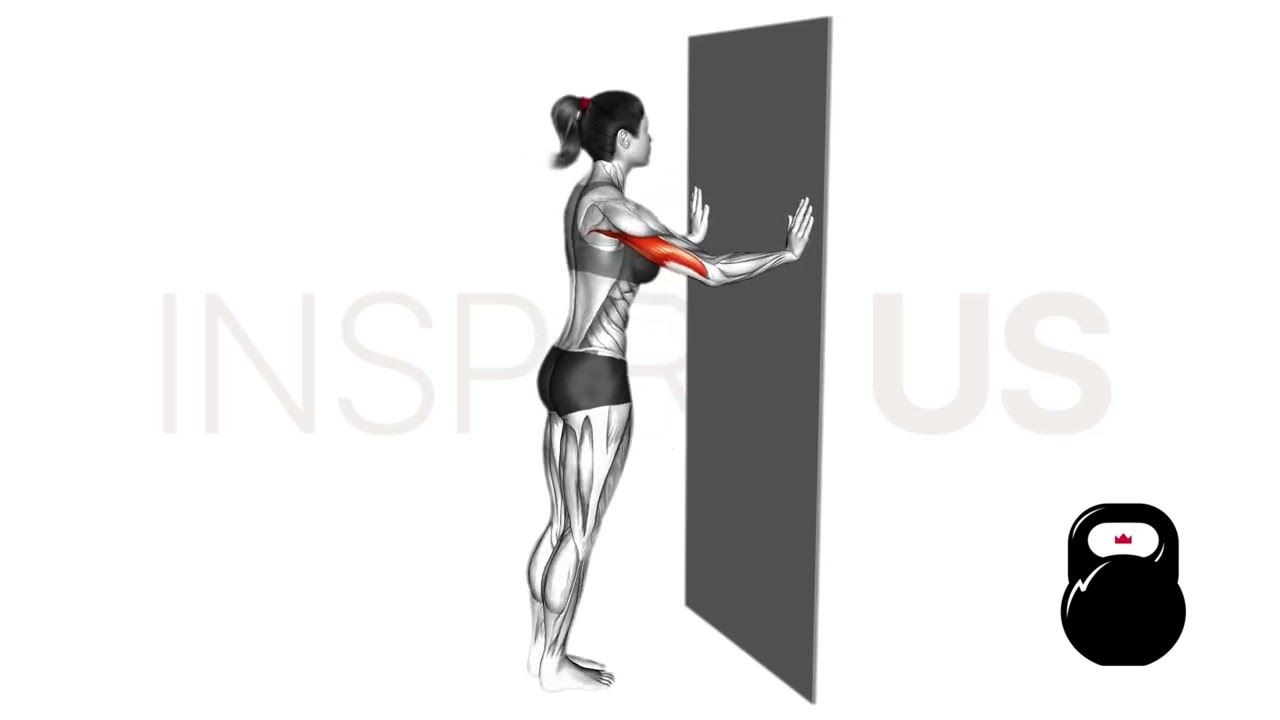Wall Push Up: Benefits, Muscles Worked, and More
How to do Wall Push-Ups
To perform wall push-ups, the exerciser will need to position themselves at arm’s length from a wall, their feet set hip width apart and their body upright.
Placing both hands at shoulder-height and shoulder-width apart along the wall, the exerciser will bend at the elbows as they lean their torso forwards - stopping once they are within several inches of touching the wall.
To complete the repetition, the exerciser will then push through their palms and straighten their elbows, returning themselves to the original upright position.
What Muscles do Wall Push-Ups Work?
Wall push-ups target more than a single muscle group at once. The muscles involved in dynamic movement are referred to as “mover” or “mobilizer” muscles, and those contracted in a static capacity are referred to as “stabilizer” muscles.

Primary and Secondary Movers
During a repetition of the wall push-up, it is the pectorals, anterior deltoid head, triceps brachii and serratus anterior that contribute the majority of the force needed.
Because of their intense involvement in the exercise, it is the primary and secondary movers that receive the most benefit from performing wall push-ups.
Stabilizer Muscles
Likewise, the muscles contracted in an isometric capacity are those of the core and the spinal stabilizers.
Unlike with conventional push-ups, wall push-ups involve far less isometric contraction due to the exerciser’s standing stance.
What are the Benefits of Doing Wall Push-Ups?
Although less intense than other push-up variations, wall push-ups are still effective for achieving the following benefits.
Builds Strength and Mass in the Upper Body
Wall push-ups are excellent for targeting muscle groups like the pectorals, triceps and deltoids with high volume - especially in cases where the lifter cannot otherwise perform a regular push-up. This allows for the exerciser to build both strength and mass in the push muscles of their upper body.

In order to maximize the muscular development derived from wall push-ups, it is best to perform each repetition in a slow manner that focuses on achieving a full range of motion.
Greatly Reduced Pressure on the Wrists
One reason athletes may prefer wall push-ups over other push-up variations is its greatly reduced pressure on the wrists.
While no substitute for proper physical rehabilitation, individuals who have already recovered from a wrist injury (or have poor mobility) can use the wall push-up for retaining the same muscular recruitment as a conventional push-up without actually doing one.
Not Limited by Core Stability or Endurance
Similarly, individuals who have trouble completing a full set of push-ups due to core muscle instability or weakness can turn to wall push-ups as an alternative.
Because wall push-ups are performed in a standing position, the muscles of the core play a far lesser role, and as such are not likely to limit the volume of the set.
Even when using wall push-ups as a less core-intensive alternative to regular push-ups, remember to include core isolation exercises into your workout so as to strengthen them.
Reinforces Push-Up Mechanics
Wall push-ups and conventional push-ups share quite a number of mechanics related to elbow, scapula and shoulder movement. This creates the perfect opportunity for novice exercisers to practice performing regular push-ups without the limitations and risks that come with doing so.
In order to use wall push-ups as a method of mastering push-up form, each repetition should be slowed so the exerciser can focus on learning the appropriate mechanics.
Common Wall Push-Up Mistakes to Avoid
For the safest and most effective workout, avoid these common mistakes when doing wall push-ups.
Standing too Close to the Wall
Despite being called wall push-ups, performing the exercise does not necessarily require the performer to stand parallel to the wall.
In fact, in order to properly engage the muscles of the upper body, it is best for some distance between the wall and the exerciser be present so they have to incline their torso as they press against it.
Of course, stepping away will make the exercise more difficult to perform, and it is important to pick the appropriate distance from the wall according to your current level of physical strength.
Further from the wall equates to greater intensity; Closer to the wall equates to less intensity.
Using Excessive Momentum
The wall push-up is meant to be performed with time under tension in mind - meaning that each repetition should be performed in not only a slow manner, but also a controlled one.
This requires no momentum or swinging take place during the repetition, as doing so will reduce the effectiveness of the exercise and potentially lead to poor form.
Individuals who have trouble maintaining a proper length of time under tension for each repetition can count up to three seconds over the two phases of the movement.
Narrow or Wide Hand Placement
In order to evenly distribute force throughout the push muscles of the upper body, the hands should be placed approximately shoulder-width apart if not slightly wider.
Adopting a stance that is narrower than this will shift more emphasis towards the triceps, whereas a wider hand placement will shift emphasis towards the chest.
Both cases largely defeat the purpose of the wall push-up as an entry to regular push-ups, but may also be a suitable change in stance for emphasizing one part of the upper body more.
Alternatives to the Wall Push-Up
Whether you’re seeking a similarly novice-friendly alternative or wish to up the intensity of the wall push-up, these three alternatives are a good place to start.
Band Assisted Push-Ups
Simply a conventional push-up with the assistance of a resistance band around the body, the band assisted push-up is quite similar to the wall push-up in its capacity to act as an entry into push-up variation exercises.

Unlike wall push-ups, band assisted push-ups are performed with the exerciser in the standard push-up position on the floor, and as such are a more useful alternative for practicing proper form.
Knee Push-Ups
Knee push-ups are a more intense alternative to wall push-ups, as they are performed with the exerciser lying on the ground with the knees drawn upwards.

Similarly less difficult than conventional push-ups, knee push-ups may be used as a progression from wall push-ups in a manner that features greater core muscle recruitment and resistance with each repetition.
Incline Push-Ups
Also an excellent progression from wall push-ups - the incline push-up is simply a conventional push-up performed with the upper body raised higher than the rest of the body.
This creates an exercise that is similar in recruitment pattern and mechanics to the regular push-up, but involves less resistance and is thereby easier to perform by novices.

Incline push-ups are an appropriate alternative to wall push-ups for exercisers that find the latter to be too easy for their current level of strength.
Frequently Asked Questions (FAQ)
Is Doing Wall Push-Ups Effective?
Yes.
Wall push-ups are an effective tool for strengthening the chest, triceps and shoulders with little risk of injury.
Do Wall Push-Ups Reduce Belly Fat?
Wall push-ups burn a small amount of calories with each repetition, meaning that it is possible for them to reduce belly fat when combined with aerobic exercise and a dietary caloric deficit.
Keep in mind though - spot fat reduction is impossible.
How Many Wall Push-Ups Should You Do a Day?
A good starting point is to perform wall push-ups for 8-12 repetitions per set.
However, keep in mind that the wall push-up is not meant to be performed on a daily basis, and it is important to take 24-48 hours of recovery between workouts involving the same muscle groups.
Final Thoughts
Wall push-ups are an excellent first step into the world of bodyweight training - but should only be one part of a more comprehensive calisthenics program.
Combine wall push-ups with exercises like the bench dip, bodyweight squat and inverted row so as to ensure the entire body develops equally.
However, if you have been prescribed the wall push-up for the purposes of rehabilitation, remember to follow your medical professional’s advice to the letter.
References
1. Lin JJ, Hsieh SC, Cheng WC, et al.: Adaptive patterns of movement during arm elevation test in patients with shoulder impingement syndrome. J Orthop Res, 2011, 29: 653–657.
2. Kotarsky, Christopher J et al. “Effect of Progressive Calisthenic Push-up Training on Muscle Strength and Thickness.” Journal of strength and conditioning research vol. 32,3 (2018): 651-659. doi:10.1519/JSC.0000000000002345

